World Cup. Team Mexico was out there playing hard - winning some, and losing. The atmosphere was pretty upbeat and high when Mexico tied with South Africa and beat France. (That lasted a short while.) Even though Mexico is now out of the running, I’ll never forget hearing people scream “¡¡GOOOOOOOOL!!” in the city center, in friend’s homes, at work, and even on the ruta (bus). Here we took some of the students to the zócalo (Cuernavaca’s city center) to watch the game. Travel to Mexico City. Me, Katherine and Sara on our small boat in Xochimilco. (Frida and Diego lived in this house - 1929-1954) “I’m Fine!” Now the resounding “1-2-3! I’m Fine!” has become my morning welcome. In fact, some of the teachers have even started calling me “Katie ‘I’m Fine!’ Nelson.” Sounds about right. Farewell visit. Fin del curso. Colorful balloons, streamers and students’ artwork decorated GADI (the school/day center where I work) for our end-of-the-year party. Families and friends came to celebrate an incredible year and watch their children and siblings sing, dance, do some tae-kwon-do for the crowd, and receive lots of awards. When it was all over we devoured delicious tlacoyos to top off what was a fantastic run of events! Farewell dinner for coworkers and host families. I was really touched that my coworkers came for the dinner last Sunday. Here I am with Viri, Liz, her baby Erik, and Rosita. But in these last few days, my focus is on being HERE. To soak in all that I can, continue the process of saying goodbyes, and soon I’ll be able to rejoin my family and friends back home.
10 Comments
At the end of May, our YAGM group met for our second-to-last retreat. While we were there, our country coordinator, Andrea asked us to reflect on this year in Mexico, what we've discovered about ourselves, and our fears and excitement about returning home. Given that we have less than a month and a half left here there's a lot to think about. This letter, then, is for the both of us. Dear family and friends: Ten months ago I packed my bags and my courage, and arrived in Mexico full of nerves and excitement - with hardly a clue about how the direction of this year would unfold. Waking up to the sounds of rutas, roosters and ranchera music seemed so strange at first to my suburban Chicago ears. And I wasn’t sure what to think of eating slimy nopales (cactus paddles), chayote (prickly pear), or the flor de calabaza (squash blossom) tucked inside my quesadillas. Meal after meal, I wondered about the variety of chile as I sniffled my way through colorful plates covered in spicy salsas. Navigating the city center seemed like a maze - as if back in the 1500s, Cuernavaca’s original city planners sat down, played a game of pick-up sticks, and decided that's how the city would be laid out. Still, it wasn’t until I arrived in the mountainside village (2 hours outside of Cuernavaca) that I realized I was really in for something different -- quickly setting aside my fondness for four-legged creatures while learning to anticipate aggressive dogs during home visits, often carrying an umbrella (my weapon of choice) or a small rock with me, just in case. Oh, yes. There have been times when Mexico felt like a world away from home.
I was there. I was there for the ordinary and milestone moments. To clip toe-nails, hold someone's hand, to help prepare meals, give someone a bath; to play, to color and read storybooks and letters. I was there when a young man recovered his eyesight after cataract surgery. I was there when a mother said her final goodbyes to her dying daughter. I was there early one morning after a family lost a loved one to cancer. I was there when one became two. May it be one-on-one, or in a small circle, I’m ready to share these stories with you when I return. Remember that as my voice begins to tell you, that same breath asks to hear your stories, too. It amazes me that even from afar you have held a special place in my heart. I’ve felt your prayers, your well-wishes, your love and concern; and I am deeply, deeply grateful for your presence. So it is that I return to you filled with a rumbling, aching hunger in my heart that only your stories will satisfy. I don’t know yet how to make real the things that I’ve experienced except to live moment to moment, situation to situation, with new stories, my story, and under my feet are the common stories we share. These are the things of the Spirit and the heart. These are the things that cannot exist or grow outside of community. It’s what I had to go to Mexico to recognize and what returning home calls on me to believe and feel. Thank you. Thank you for who you are. Thank you for being such an integral part of the gifts and abilities I brought with me here. Thank you for being the community that sent me on this journey. And until I can be home with you in person, I continue to feel your closeness in such a visceral way. Back in May I found myself in and out of work due to a bunch of holidays. We had: · Dia de la Santa Cruz (Holy Cross Day) · Cinco de Mayo (honoring the victory over the French army in at the Battle of Puebla in 1862) · Dia de Madre (Mother’s Day) While I really missed working in the bakery, learning new dance moves, and practicing English with my enthusiastic chamaquitos at GADI, I had an incredible adventure with friends Katherine, Peter, and Sara in the city of Puebla for Cinco de Mayo celebrations.  Katherine, me and Sara in front of the main cathedral.  The food certainly lived up to its reputation. Mmm, mole poblano, a thick sauce made of different kinds of spices, chiles and chocolate.  It just happened that we were in town for the last few days of a major music and cultural festival called Barroquisimo, which meant we got to see a number of free concerts all around the city. 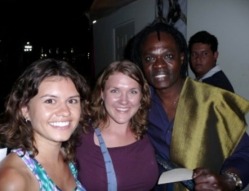 AND, to my surprise, the festival ended with a concert by Baaba Maal - a Senegalese pop/world music artist who I’ve listened to since growing up in West Africa! After the concert: Katherine, me and Baaba. Then on Cinco de Mayo, May 5th, we made our way through swarms of people with giant umbrellas in order to watch the parade. We had a hard time finding a good spot to see all the action and eventually climbed partway up a giant statue to get a better view. The parade itself was kind of underwhelming since it was basically hours of soldiers and military tanks rolling down the street and only a few floats and high school marching bands to speak of.
Besides the parade being a bust, the trip was fantastic. Probably the most memorable was our visit to the Pyramid of Cholula - famous for its system of underground tunnels and also considered the world’s widest pyramid. Only what made our trip out there so interesting wasn’t necessarily for the pyramid itself. We started out with a pretty laidback morning walking around the ruins and looking inside the church built on the top of the hill; then as we started walking down the stairs from the church I noticed a familiar face sitting alongside the path. Next to spread of candies, bracelets and other crafts was Celia, a young woman from the village where I previously worked. I don’t think either of us knew what to do at first but all in an instant Celia and I were hugging and catching up on what’s happened since we last saw each other. It turns out that she’s been away from home for a while in order to help her brother sell baskets, bracelets, and whatever else they can at tourist and pilgrim sites like Cholula. It caught me completely by surprise to connect with Celia here, especially since we never had the chance to say goodbyes before leaving the community. It’s still hard to put words to this experience except to say that this was such a meaningful encounter. I didn’t even know how to express that to Celia except to tell her that I hope this hug hope wouldn’t be our last. It’s definitely that memory that will stick with me from our mini-vacation to Puebla. I shared a lot about this with my host mom and coworkers but after a few weeks now that I’m back into my normal routine at work and home, I can’t shake the feeling that more goodbyes are about to happen in this next month and a half. It’s sooner than I would have hoped but I guess now I’m on the homestretch. Already, some of the teachers at my work have already asked about when I leave Mexico, what I’ll be doing when I get home and if I’ll ever come back and visit. It's hard to think about leaving. These are uncomfortable conversations but it's understandable that they need to happen. We all need to start somehow and in some way thinking about leaving well. The major churches, pyramids, cities and quaint small towns may eventually fade into the back of my mind – but again, the ones who have made Mexico so fully part of who I am – people like Celia - simply won’t. Maybe I’ll save some of those thoughts for a future post but in the meantime I’m reminded that it’s really those who have grown so close to me this year that make life in Mexico feel like “home”. From my slice of Mexican “home” to yours, Katie Sometimes your joy is the source of your smile, but sometimes your smile can be the source of your joy. ~ Thich Nhat Hanh Maybe it’s the oppressive heatwave lately but this quote by Thich Nhat Hanh was just what I needed to come across last week. Figuratively speaking, I guess you could say that it hit me like a refreshingly cold shower! Ahhh… In any case, these timely words of wisdom and the memories they draw near allowed me to sit back and soak in the thoughts and feelings that have brought me so much joy working with students at GADI, most of whom have Down's syndrome. It’s a brief post but here are a couple joy-filled moments to share with you: “Sometimes your joy is the source of your smile…” Joy was the word that popped into my head as I was swamped with hugs last week after returning to work from some time off. Between tight squeezes and kisses on the cheek, a few of the older students couldn’t wait to say: Which actually sounded more like: Owwwa you? I fiiiiy. I realize that we won’t have perfectly fluent English students by the end of the year and that’s okay. Besides getting our facial muscles to work in a new way, the point in teaching English at GADI is to help students enjoy the satisfaction in learning something new. That sense of confidence and enthusiasm that my students exuded that morning was the source of the cheek-aching smile on my face. Now I won't be able to forget how contagious joy really is every time I cup my hands around my mouth to emphasize how to use our lips when pronouncing: “Howww arrrrrre youuu? III’mm fiiiinnne." Here are a few more pictures from the center where I work: 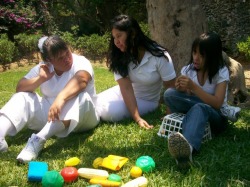 Lupita, Elsa (one of the teachers) and Carolina outside in the garden for English class. 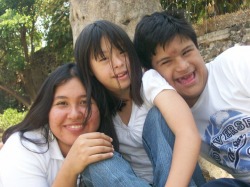 Hanging out: Elsa, Carolina and Alex  Clapping to the beat... During Semana Santa my parents came for a visit and it was quite the experience showing them around! Unfortunately my brother, Ben, wasn’t able to come along due to work and all sorts of school-related stuff - we missed you! – but he was definitely on our minds the whole time. I think Ben was especially pleased with his Mexican “recuerdos”: soccer jerseys, lucha libre masks and a pirated WWE Wrestling DVD we bought at the market. Anyway, while my parents were here, we travelled to some incredible sites:  Teotihuacan, where we climbed the world’s 3rd largest pyramid and walked around what was once the largest Mesoamerican city. 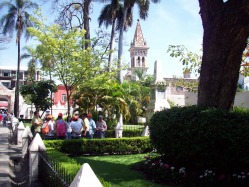 A stay in Cuernavaca to see where I live and meet my new homestay family.  Then there was Puebla, a colonial center that is home to many ornate, gold churches, Talavera pottery, and mouth-watering food (tacos arabe, mole, churros, and so much more!). 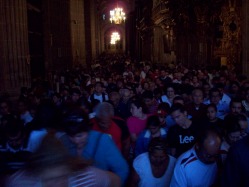 And, finally, we found ourselves in sprawling, urban Mexico City where it seemed like every single one of the 20 million people who live there were also out in the crowds for the tail-end of all the Semana Santa activities. Look closely: there’s my mom on the left leaving the crowded Mexico City Metropolitan Cathedral. It was fun to visit a lot of these places together but what I enjoyed most was the chance for my parents and Mexican homestay family to meet each other. We all got together at the house for a few hours of cake, music and good conversation – even despite the language barriers! It was one of those wonderfully surprising moments that allowed me how to experience genuine hospitality and family in a new way. Fortunately, after my mom and dad left I didn’t have to spend Easter alone wallowing in feelings of homesickness. I did feel a little sad about the fact that Easter this year would not be a big occasion with my homestay family but instead, a few of the other volunteers and I met for an Easter service and brunch at an English-speaking church where fellow volunteer Peter sings in the choir. It was nice to get dressed up, meet with friends and do something that felt familiar (i.e. church, singing, the tons of flowers and soft smells, cute outfits, Easter bonnets, etc etc.). More than anything else, it was special to find good fellowship in the company of the other volunteers that morning and later at our country-coordinator’s house for a monthly meeting/Easter get-together. It was a busy day but it felt like a nice way to cap off a memorable few weeks of religious and cultural significance with the ones who have held me with immense grace and care so far – especially on the heels on some big changes. A classy Easter morning brunch complete with mimosas! Katherine, Peter and Sara. A while back when my parents were here and as all the Semana Santa festivities took place, the weather was warming up little by little. Now I find myself in the midst of one of the hottest months in this part of Mexico. Cuernavaca’s hilly landscape is transformed into a parched, brown terrain until the rains come in June. In this heat, water is scarce and cold showers are a treat. I haven't had any encounters with scorpions yet but as the ants, spiders and other insects come out in full force, and the cockroaches in particular seem to be multiplying, I’m beginning to perfect cockroach-murdering skills. A quick whack or squishing them with my flip-flops seems to do the trick and I’m still basking in the glow of my personal record a few weeks ago: 4 dead cockroaches all at once - even managing to kill one mid-flight! Yeah! I’m definitely looking ahead to rain clouds and cool breezes but, until then, there’s a wedding that I’ve been asked to be part of at the end of this week. I have somewhat of a vague idea of what to expect (I wish I knew more but I’m just going to have to relax and go along with the surprises on this one – my dress isn’t even made yet!) but it sounds like it will be a fun time and a good way to get to know the family better. I can promise more details in a bit… with pictures to come. In the meantime I promise more updates soon, wishing you all well, Katie As I sit here writing this blog post it’s hard for me to get my head around the fact that 8 months ago I arrived with my two suitcases and laptop bag – wide-eyed and full of expectation - ready to immerse myself in this year of service and learning in Mexico.
It all began as an adventure into the entirely unknown and the accompanying feelings were fresh and new. I had a constant bundle of nerves and excitement vibrating all around me; and there were all sorts of wonderings and questions: who would be my new friends? who I would confide in? when would I begin to trust and share parts of this new reality? And…and? Fast forward to April. April! I can’t help but look back on how these past months have taught me so much about who I am (probably much more so than who others are). Somedays it’s just plain hard to put into words the ways I have been shaped and formed by the people near to me and the places I’ve been. It leaves me feeling grounded in some ways, while in others I’m left not knowing what to think, or wonder if my values seem as clear as I thought they were. At this point, I’ve found a certain comfort with that reality. Although “comfortable” would not have been the word I used a month and a half ago when, once again, I found myself holding on to two suitcases and a laptop bag – sensing the all-too-familiar feeling of unknown swell within me. Nervous, unsettled, but determined and trusting that it will all turn out alright. Enter my homestay mom, Mary Paz. Paz, as most people call her (Paz means Peace in Spanish), is this bright, energetic and full of life woman who adores her family and even calls me her “hija/daughter.” She’s fun to go on walks with and talk together when I get back from work either at her sewing shop or at home. As a seamstress, Paz had been able to travel to Chiapas and Guatemala to lead sewing workshops for women who are interested in income generation (setting up their own shops in their own communities + starting small businesses and co-ops). Paz’s stories of Chiapas, which is the furthest south and one of the poorest states in Mexico, are striking. While Paz was there, she was invited to enter into Zapatista communities and work within churches to organize women and teach them basic-to-advanced sewing skills. [To learn more about the Zapatistas, or Ejército Zapatista de Liberación Nacional, EZLN), click on this link.] Paz says that she and the other volunteers would sleep on the floor or on tables for weeks at a time. It was a challenging experience but a huge opportunity to work closely with the rural poor. It’s so clear that she deeply cares for the people she met there, and she’s eager to share the things she learned along the way. Now to the house we live in... Currently we’re in the final stages of dust, debris, and non-stop construction racket! When I moved in 7 weeks ago the construction team promised us that they would finish the inside of the house in 2 weeks. Then it would be 2 more weeks to work on the backyard. Now, mid-April, they assure us that there’s only 3 weeks to go! It’s kind of hard not to feel frustrated by all that’s going on but at this point there’s really no alternative than to roll with the punches. I guess once you get used to 7 weeks of construction, what’s 10? It was a big deal to see things moved into the house a few weeks ago because when I got here my room was complete but there wasn’t even a fridge or a stove. So in those first few weeks, Paz and I would go for walks at night, grab some dinner at family-run neighborhood restaurants (basically a few tables and chairs in front of the house) and start to get to know each other over warm quesadillas and spicy salsas. It's a relief to look around today and see that things are finally coming together. For one, we can cook and store food! Plus, last week, furniture was moved in to the house - except we’re not exactly settled in because the couch, love seat and chairs are still all covered in plastic and tipped over sideways along the edge of the living room! This time of waiting for construction to end is teaching me a lot about the value of patience. That’s been pretty obvious. Never before have I heard the words repeated so often: “Poco a poco/Little by little” and “Ya/Done” (or in this case, “almost over”). I feel my attitude shifting somewhat from finding ways to “get through” the dust and noise to instead embrace my homestay mom Paz’s openness to taking things day-by-day and try to make the best of whatever moment or stage of construction that we’re in. We’ll feel settled in eventually. And now is one of those times where I really need to practice patience, to allow my capacity for being patient increase. Practice makes patience, I tell myself, in order for the big picture to come into focus. This is what change requires. There was a moment a few weeks ago that brought a smile to my face. From where I was standing at the back of the room, I caught myself smiling in one of those huge, cheek-aching grins as I scanned the room and saw 17 glowing faces staring back at me - all rosy as the blood rushed to their heads in the Down Dog yoga position. Welcome to my new work site, G.A.D.I., a day center for children and adolescents with Down’s syndrome. G.A.D.I. stands for Grupo Activo Down Independiente, which literally translates to: Group-Active-Down’s-Independent. It’s a small center with a lot of heart, consisting of teachers, parents, volunteers, and special students. Since children with special needs often face educational and social limitations in Mexican public schools, G.A.D.I. is a safe space to make friends, gain a basic education, and develop independent life skills. What I like about the environment here is the mutuality in participation by staff, parents and students. Also, there's no cut-off age when students are asked to leave; in fact, the oldest student is 54 years-old! Each day begins with an activity like yoga, tae-kwon-doe, or dance. Then the students split into 3 classrooms until lunch. One group is working on writing sentences, reading, basic math, etc., meanwhile another practices shapes, numbers, days of the week. The third classroom is used for speech therapies. At 11:30 we all eat together at one big table. After recess, depending on the day, there is painting, gardening, an after-school recycling program, baking in the on-site bakery - even bowling! It’s certainly no free-for-all but there’s a lot of high-energy pulsing around all day every day. In my first two weeks there’s been an escape-artist that we had to chase down the street - twice; the separating of a pair of non-stop ‘cha-cha’ dancers in the middle of class; and the taking away of a whole bunch of distracting and noisy Spiderman and Batman games. Oh, I've also confiscated a bottle of tequila after a student snuck it into the center and started serving his friends at lunch time.
I’ve also received countless gooey kisses on the cheek; helped tie shoe-laces after little shoes stick out in front of me with a simultaneous question/demand “Por favor?!/Please?!”; plus big, wide open arms that lock around me at the end of the day. As I struggle to find my role and figure out how I can be best used, what strikes me the most is that each day is incredible mix of routine and unexpected situations. Lately I’ve put a lot of attention to getting to know the students better, to sit by them at lunch and try to be as present as possible. Everyday with the students at G.A.D.I. is a reminder that I’m really here to be – not do. Maybe that’s what bubbled up inside of me as I stretched into a yoga position that Wednesday morning - and burst into a spontaneous smile. In the packing frenzy that followed the recent changes in my living situation and site placement, I considered how important my boots have been since I first put them on in August. I remember buying them before I left for Mexico and feeling absolutely sure that they would hold up considering the many miles of use they would endure in the coming year.
They were many things: breathable, lightweight and clean! A comfortable yet sturdy pair. These trusty hiking boots have carried me up and down the village mountainside, from home to home, and there’s no doubt that they bear the signs of wear and tear (and not to mention a certain odor…). They’ve trekked throughout village roads on bright, sunny days and through rains when the rush of water running down the roads carries dirt and all sorts of not-so-clean things. They have entered hospitals, clinics, and families’ homes with dirt floors, some cement. They’ve climbed rocky terrain high up the mountain and trudged through both muddy and dry grassy areas. Now after six months of consistent use, they mean more to me than ever. And oh, the stories they tell. As a way to honor the place, people and their stories, I’d like to share with you some of the soul-satisfying moments (taken almost entirely from journal entries) that have been such a big part of my time in the village: … October 7, 2009 Working with 22-year-old Edith makes me think long and hard about “rules.” On home-visits I make the effort to shake hands with everyone but when it comes to her, part of me hesitates. I think: “She’ll hold my hand too long, or squeeze it too tight.” Edith has Cerebral Palsy and shows a lot of symptoms of arsenic poisoning. Receding gum line. Purple lips. And since she isn’t able to communicate verbally, her mom and aunt have to explain to me why she makes certain noises or behaviors. Most of the time I feel like we’re just guessing. Today Edith came out with her aunt and sat down next to me. Then she started shaking her head, clapping her hands, and slapping her feet together. It was almost like a convulsion. When her mom put her hands back in her lap, I noticed she couldn’t control her saliva, another symptom of arsenic poisoning, and it was running down her chin and her hands were somehow covered in this sticky dribble. “Oh please,” was my reaction. I knew what would come next and I really did not want to hold her hand. Moments later when she reached out and grabbed my hand, it was all I could contain to not flinch and let go right away. “Not clean!” I thought to myself, trying hard not to let any of this show on my face. It took every part of my inner reserves to force myself to squeeze her hand back so that I would BE with Edith and not just go through the motions. I tried to erase whatever it was that told me to treat Edith differently because of her hygiene issue. More than anything, I sat there wanting to want to hold her hand, to tear down the social rules about cleanliness that act as barriers in moments like this. Edith reminds me of what I need to learn, reflect on, and who I need to become in that process. I pray so hard to grow to love every part of her this year, even when saliva drips down her chin. She is God’s beloved. Why can I not see that right away? Later I went to Ofelia’s house after promising to read “The Three Little Pigs.” It was strange, though, in a home made of corn stalks, adobe and a tarpaper roof, to be reading a story about how a mean fox could “huff and puff and blow your house down.” A house just like this one. January 14, 2010 Antonio is doing better now that he’s out of the hospital but still needs a lot of care. Today Gabriela and I brought his mom a few bananas, suero (a rehydration drink), and his medication. When we reached their house Marisol, one of Antonio’s older sisters, ran up and gave me a huge hug! Scooping her up in my arms I said: “What’s my name?” “Katie!” “Yes it is! And how old are you?” “Eight,” she said grinning. I started laughing as her mom yelled from the doorway: “Noooooo, you’re four!!” Hahaha… Love. Her. January 29, 2010 As we were finishing dinner last night, two of the midwives came over and said the words I’ve wanted to hear all these months: Parto/Birth! The midwives took their supplies and gloves out of the clinic and we hustled up to Susi’s house. The whole way there we were alert and wary of the dogs barking and drunk men along the way. In a well-lit one-room house, Susi was laying on a bed, surrounded by her in-laws and a neighbor. They whispered encouraging words to support her along her labor. Every so often she would get up, sip tea, and walk around the room. She moaned with each contraction, putting her hands on her lower back, exhaling, trying to find a rhythm with her breath. It seemed like the pain had become more intense but her contractions were still far apart. By 1am the midwives decided to let Susi rest and told us to return to the Center. They said that when it was time to give birth, a family member would call come and get us. Not much later, by 4am we were hurrying up the road again. This time, Susi was in bed covered by blankets and covered her head with a shawl. One of the midwives was under the blanket with a flashlight telling her, “That’s right. Keep going. That’s right.” Susi’s moans were so soft that I could barely hear her. The hushed voices that had encouraged her until this point were now stronger and louder: “Yes, Susi. You can do it, Susi. Come on.” Then there was a splash sound! The midwife’s hand reached across the bed for the right supplies and all in an instant a healthy baby girl was born! Tears, hugs, and well-wishes filled the room. Absolutely incredible. What’s amazing is that all this was done under a blanket. “You might as well do it with your eyes closed,” someone said. And I bet they could. We left at 6:30 a.m. Everyone went back to the Center for another hour of sleep but Sarah and I had to meet Socorro, a special woman in front of the church so she could catch a bus to the hospital for a prenatal check-up. No, Socorro was not there. With no other choice but to go to her house, Sarah and I ran to her house, entered her room, woke her up, threw some clothes on her and started running again. Down the hill, Sarah kept saying: “She must think she’s dreaming!” She was right. It felt so surreal. All sorts of dogs were growling and barking at us, coming super close to our legs and I thought they might bite us. We grabbed some rocks and pretended to throw them but the dogs just wouldn’t let up. Ah, so scary! I tightened my grip on 7-month pregnant Socorro’s hand and we rushed to the bottom of the hill. Gone. The bus left without us. Oh, Socorro, I’m so sorry. In the end, the midwife who had delivered the baby not two hours earlier agreed to help find a later bus and accompany Socorro to her appointment. I so admire the women here. For their guts and boldness! For taking risks, for being who they are! January 23, 2010 Esperanza, a 101 year-old woman who lives alone, finally has a cat to keep her company. She calls it Panchita, little Pancha. February 12, 2010 - Then meeting Elidia on the road. She keeps her hand on my elbow as she tells me about her day’s activities. Well, until these two encounters, today felt like a frantic race to get everything done. Slow down. I get it now. Their way of being makes this so easy to understand. These boots, the stories they tell and the stories we share are all part of an incredible journey that has allowed me to walk alongside - and be transformed by - the community and specific people I was placed with. In the meantime, I’m learning to trust. Trusting that the new place, people and all the surprises that are just around the bend shed light on this journey still. Most of all, trusting that in this next step God will be waiting for me there. Grateful for you, who accompany me on this path, paso a paso, step by step, Katie Dear friends and family,
Since February there have been some major changes in my site placement and living situation, ultimately reshaping the direction of the remainder of my time in Mexico. After an unexpected and heart-crushing turn of events, a whirlwind of social and legal issues in the village became heated and intense. Until things subside, the organization had to significantly decrease its presence in the village and put a halt to the work that is being carried out. Sarah and I ended our placement and without having the chance to visit the village one last time and say goodbye. It’s been tough. This week has been a sort of physical and spiritual “limbo” for me. I feel that all this upheaval has left me feeling torn and uprooted. I’ve said painful goodbyes to our coworkers in the office but haven’t had that same chance with those dear to me in the village. Plus there’s been a lot of packing and unpacking in a few short days – and more to come in the next phase (moving in with a homestay family in Cuernavaca and adjusting to a new work site). After Sarah and I carefully packed our bags and left the apartment, our country coordinator Andrea and her husband Luke graciously took us in for a week (even though they were in the midst of a move, too). We settled in with them for a couple days and then moved into their new house. Here we’ve been staying while Andrea sorts out separate placement sites and living situations. It’s true, as someone pointed out, that’s we’re in good hands with Andrea “at the helm.” But even before the shifts from apartment to house, and house again, last Sunday I got to see familiar faces during a Skype conversation with my home congregation, St. Luke’s. I could feel the love in that room! It was so wonderful to share what my experience has been like in the village, to describe the place, the people, and the stories we share. More than anything, it gave me new energy to and openness to embrace what’s in front of me. The up-rootedness that seems to be unfolding all around me will gradually fade into the past. Of that I’m sure. Still, I don’t know what comes next. What I’m most grateful for now is the tons of support and encouragement like what I experienced last Sunday. I know the joys, struggles, and vulnerability in these past weeks are held with great care and empathy; transforming, in a sense, this time of up-rootedness into feelings of rootedness. From the bottom of my heart, thanks to each and every one of you for being who you are and helping me grow from here. In peace, Katie We left the border and returned to Cuernavaca. Except the border is not just there. With the faces and stories of those we met sinking into my conscience, I recognize that it’s in our governmental policies, in our communities, our churches, and in our conversations. |
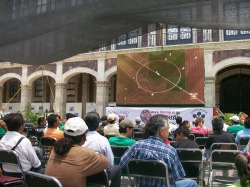

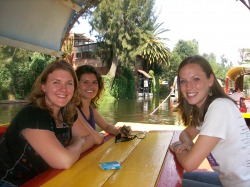
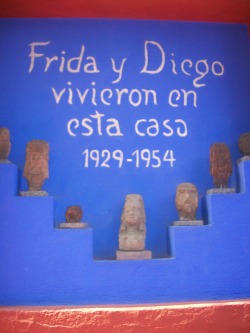
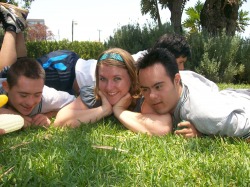

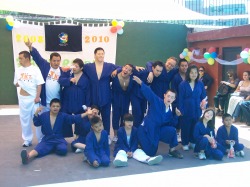

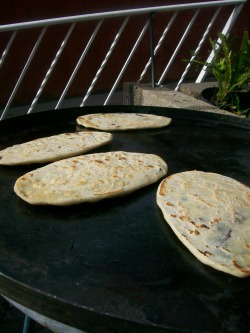
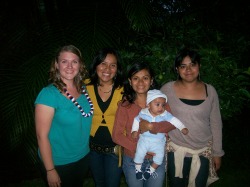
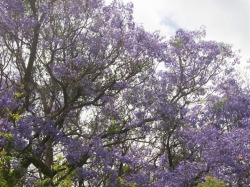




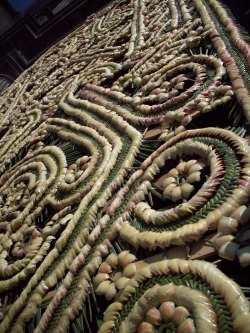
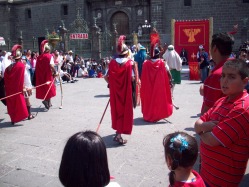
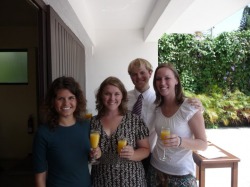
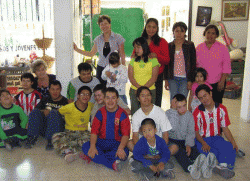

 RSS Feed
RSS Feed